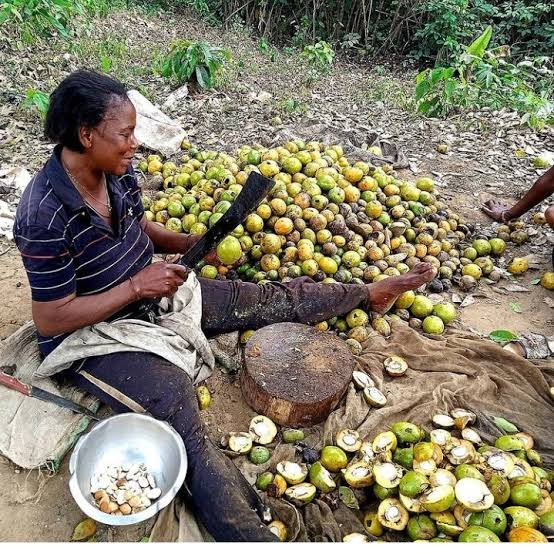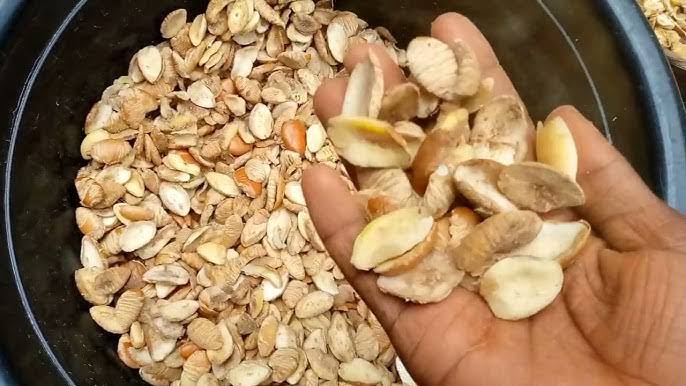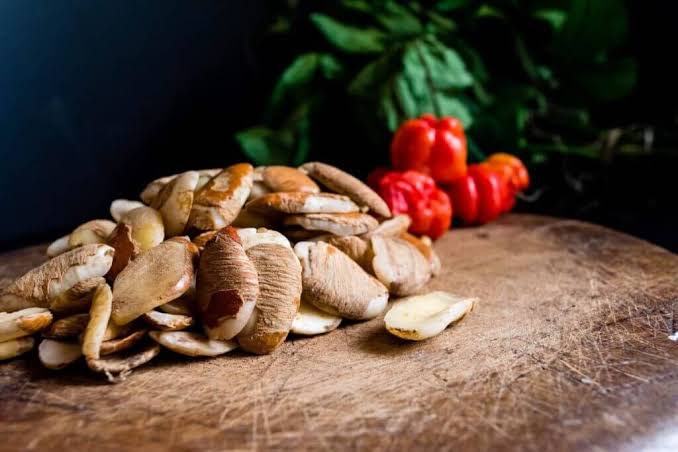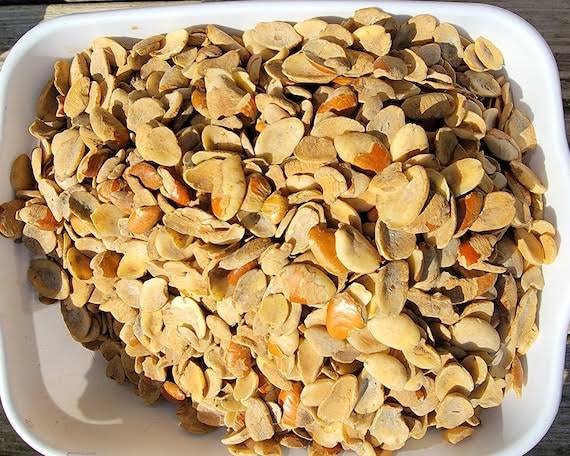Ogbono seed, derived from the fruit of the ogbono tree (Irvingia gabonensis), is a remarkable ingredient that holds a significant place in the culinary and cultural practices of West Africa.
This seed has not only culinary value but also a rich history and profound cultural significance. Understanding its origin and importance reveals why ogbono is celebrated and utilized in various ways.
The ogbono tree is indigenous to the tropical regions of West and Central Africa, with a particular prevalence in countries like Nigeria, Cameroon, and the Democratic Republic of Congo. This tree can reach heights of up to 20 meters and features a broad canopy, making it an important species within its ecosystem.
The ogbono tree typically flourishes in forested areas and is often found in regions with rich, well-drained soil. It thrives in a climate that provides consistent rainfall and moderate temperatures, which are conducive to its growth.
The fruit of the ogbono tree is a drupe, which develops from the tree’s small, yellowish flowers and matures into an oval-shaped fruit that is green initially but turns brownish or yellow when ripe. Each fruit contains several seeds, which are extracted for various uses.
Harvesting ogbono seeds begins with the collection of ripe ogbono fruit. Farmers and local communities often participate in this process, carefully selecting only the best specimens to ensure quality. After harvesting, the fruits are typically allowed to ripen further, softening the outer flesh for easier extraction of the seeds.
Once the fruit is ready, it is split open to reveal the seeds, which are then dried for future use. This meticulous process of harvesting and processing not only underscores the importance of ogbono in local economies but also highlights traditional practices that have been passed down through generations.
The cultural significance of ogbono seed extends beyond its practical uses in the kitchen. In many West African communities, ogbono seed is revered for its health benefits, which are rooted in traditional medicine.
The ogbono fruit benefits include digestive support, as its high fiber content aids in promoting bowel regularity. Moreover, the seeds are believed to have medicinal properties that contribute to overall health and wellness.
Traditional healers often incorporate ogbono seeds into herbal remedies, recognizing their potential to alleviate various ailments. Culinary traditions surrounding the ogbono seed further emphasize its significance.
In West Africa, ogbono is commonly used as a thickening agent in soups and stews, contributing a unique flavor and texture to dishes. The seeds can be ground into a fine powder and incorporated into various recipes, enhancing the nutritional profile of meals.
For many families, dishes made with ogbono are not only a staple but also a source of pride, often prepared during special occasions and communal gatherings. This communal aspect of cooking and sharing meals underscores the role of ogbono in fostering social bonds and cultural identity within communities.
The economic importance of ogbono seed cannot be overstated. Many rural households depend on the cultivation and processing of ogbono for their livelihoods. The demand for ogbono products in local and international markets has prompted increased cultivation of the ogbono tree, promoting sustainable agricultural practices.
Farmers often engage in agroforestry, cultivating ogbono alongside other crops, thereby enhancing biodiversity and soil health. This sustainable approach to farming not only supports local economies but also contributes to environmental conservation efforts.
Moreover, as awareness of the health benefits of ogbono seeds grows, so does their appeal in global markets. Researchers and nutritionists have begun to recognize ogbono seed as a valuable addition to modern diets, citing its potential for weight management and digestive health.
This shift in perception has the potential to create new opportunities for farmers and communities that rely on ogbono production, opening doors to international trade and increased income.
Read Also: Benefits of Eating Bananas at Night
How to Harvest and Process Ogbono Seed

The process of harvesting and processing ogbono seed from the ogbono fruit is an essential practice that not only ensures the availability of this valuable ingredient but also reflects the rich cultural heritage and agricultural traditions of West Africa.
Step 1: Identifying the Right Time for Harvesting
The first step in harvesting ogbono seed is determining the right time to pick the ogbono fruit. The fruit typically ripens when it changes from a green color to a brownish or yellow hue. This color change indicates that the fruit is mature and ready for harvesting.
Harvesting too early can lead to underdeveloped seeds, while waiting too long may result in spoilage. Local farmers often rely on experience and traditional knowledge to recognize the signs of ripeness, ensuring that only the best fruits are selected.
Step 2: Gathering Tools and Equipment
Before heading out to harvest, gather the necessary tools and equipment. Common tools include:
- Baskets or containers: For collecting and transporting the harvested fruit.
- Ladders or climbing gear: To safely reach high branches of the ogbono tree where the fruits are located.
- Cutting tools: Such as knives or machetes, to cut the fruit from the branches.
- Protective gear: Gloves and hats to ensure safety and comfort while working in the field.
Having the right tools ensures an efficient and safe harvesting process.
Step 3: Harvesting the Ogbono Fruit
Once you have identified ripe ogbono fruit and gathered your tools, it’s time to start harvesting. The following techniques can help ensure a successful harvest:
1. Climbing the Tree: If the ogbono fruits are high up, use a ladder or climbing gear to reach them safely. Always ensure that your climbing equipment is secure and stable to prevent accidents.
2. Picking the Fruit: Gently twist or cut the ogbono fruit from the branches, taking care not to damage the tree or the surrounding fruit. Collect the fruits in your basket or container, ensuring that they do not get crushed.
3. Sorting the Fruits: As you collect the fruits, sort them into two categories: ripe and unripe. Only ripe ogbono fruits should be harvested for processing, as they yield the best seeds.
Step 4: Ripening and Preparation for Extraction
After harvesting, the ogbono fruits need to undergo a short ripening process before extracting the seeds. This step is crucial for softening the outer flesh, making it easier to extract the seeds.
1. Allowing for Further Ripening: Place the harvested ogbono fruits in a shaded area or a well-ventilated room for a few days. This allows the fruits to soften further, facilitating easier extraction of the seeds.
2. Preparing for Extraction: Once the fruits have ripened sufficiently, prepare for the extraction process by gathering your tools, such as knives or other cutting instruments.
Step 5: Extracting the Seeds
The extraction of ogbono seeds from the fruit is a delicate process. Follow these steps for effective extraction:
1. Cutting the Fruit Open: Use a sharp knife to carefully slice open the ripe ogbono fruit. Cut along its length to avoid damaging the seeds inside.
2. Removing the Seeds: Gently scoop out the seeds from the fruit’s pulp. Take care not to crush the seeds, as they need to remain intact for quality and storage.
3. Cleaning the Seeds: After extracting the seeds, clean them thoroughly to remove any remaining pulp or debris. Rinse the seeds in clean water and set them aside to dry.
Step 6: Drying the Ogbono Seeds
Drying is a crucial step in processing ogbono seeds, as it helps to preserve their quality and prevents spoilage. Follow these guidelines for effective drying:
1. Spreading the Seeds: Spread the cleaned ogbono seeds in a single layer on flat surfaces such as mats, trays, or clean cloths. Ensure that the seeds are not piled on top of one another to promote even drying.
2. Sun Drying: Place the seeds in direct sunlight for several days, turning them regularly to ensure uniform drying. The seeds should be dried until they are hard and no moisture remains.
3. Monitoring the Drying Process: Keep an eye on the weather conditions. If it rains or humidity is high, move the seeds to a covered area to prevent them from absorbing moisture.
Step 7: Storing the Dried Seeds
Once the ogbono seeds are fully dried, they need to be stored properly to maintain their quality and prevent spoilage. Here’s how to store them effectively:
1. Choosing Storage Containers: Use airtight containers or bags to store the dried ogbono seeds. This helps to keep moisture and pests at bay.
2. Storing in a Cool, Dry Place: Place the containers in a cool, dry location away from direct sunlight. This helps preserve the seeds’ quality and nutritional value.
3. Labeling the Containers: If you are storing different batches or varieties, label the containers with the harvest date to keep track of freshness.
Step 8: Utilizing Ogbono Seeds
With the seeds harvested, processed, and stored correctly, they are now ready for various culinary and medicinal applications. Ogbono seeds can be ground into a fine powder and used as a thickening agent in soups, stews, and sauces, adding a unique flavor and creamy texture to dishes. Moreover, the seeds are gaining popularity in health circles for their nutritional benefits, including promoting digestive health and aiding in weight management.
Nutritional Value and Cultural Significance of Ogbono Seed

Nutritional Value of Ogbono Seed
Ogbono seeds are packed with essential nutrients and beneficial compounds, making them a valuable addition to the diet. Here’s a breakdown of their nutritional components:
1. High in Healthy Fats: One of the most notable aspects of ogbono seeds is their high fat content, predominantly healthy fats such as unsaturated fatty acids.
These fats are beneficial for heart health, supporting cardiovascular function and reducing cholesterol levels. Including healthy fats in the diet is essential for maintaining energy levels and overall health.
2. Rich in Fiber: Ogbono is an excellent source of dietary fiber. This nutrient plays a crucial role in digestive health by promoting regular bowel movements and preventing constipation.
The high fiber content also helps in weight management by providing a feeling of fullness, reducing overall calorie intake. For individuals looking to maintain or lose weight, incorporating ogbono into meals can be advantageous.
3. Vitamins and Minerals: Ogbono seeds are rich in various vitamins and minerals, including:
- Vitamin A: Essential for maintaining good vision, immune function, and skin health.
- B Vitamins: Including thiamine, riboflavin, and niacin, which are important for energy production and overall metabolism.
- Calcium and Magnesium: Both vital for bone health, muscle function, and nerve transmission.
4. Antioxidant Properties: The seeds of the ogbono fruit also contain antioxidants, which help combat oxidative stress in the body. Antioxidants play a significant role in reducing inflammation and lowering the risk of chronic diseases, such as heart disease and diabetes. The presence of these compounds contributes to the overall health benefits associated with consuming ogbono.
5. Potential Health Benefits: Research suggests that ogbono seeds may offer additional health benefits, including:
- Weight Loss Support: Some studies indicate that ogbono may help in weight management by reducing appetite and enhancing fat metabolism.
- Blood Sugar Regulation: The high fiber content can aid in stabilizing blood sugar levels, making it a suitable option for individuals with diabetes or those looking to manage their blood sugar.
Cultural Significance of Ogbono Seed
The cultural significance of ogbono goes beyond its nutritional value, reflecting the traditions, practices, and social dynamics of the communities that cherish it.
1. Culinary Traditions: In West Africa, ogbono is a staple ingredient in many households, especially in Nigeria, where it is commonly used to prepare ogbono soup. This dish is celebrated for its rich, thick consistency and unique flavor.
The process of making ogbono soup often involves communal cooking, where family members come together to prepare and share meals. This not only strengthens family bonds but also reinforces cultural heritage.
2. Symbol of Identity: For many communities, ogbono serves as a symbol of identity and cultural pride. The use of indigenous ingredients like ogbono seeds reflects a deep connection to the land and local agricultural practices. Festivals and gatherings often feature ogbono dishes, celebrating the cultural significance of this ingredient and showcasing traditional culinary skills.
3. Traditional Medicine: In addition to its culinary uses, ogbono has a place in traditional medicine. Various communities utilize ogbono seeds for their potential health benefits, incorporating them into herbal remedies.
Traditional healers may prescribe ogbono for digestive issues, weight management, and other health concerns, highlighting its importance in the holistic health practices of these communities.
4. Economic Importance: The cultivation and processing of ogbono seeds contribute significantly to the local economy. Many rural households rely on ogbono as a source of income through farming and sales in local markets.
The demand for ogbono in both local and international markets has prompted increased cultivation, supporting sustainable agricultural practices and improving the livelihoods of farmers.
5. Social Gatherings and Rituals: Ogbono is often featured in social gatherings, celebrations, and rituals. Dishes prepared with ogbono are commonly served during important ceremonies, including weddings, festivals, and communal feasts. The sharing of meals prepared with ogbono fosters community spirit and reinforces social ties, making it a vital part of cultural practices.
Read Also: Uses and Benefits of Cocoyam
Culinary Uses of Ogbono Seed

1. Ogbono Soup
One of the most popular dishes featuring ogbono seeds is ogbono soup, a staple in Nigerian cuisine. This dish is cherished for its rich, thick consistency and savory flavor. The preparation of ogbono soup typically involves the following steps:
Preparation
The seeds are first ground into a fine powder. This is often done using a mortar and pestle or a blender.
a. Cooking: The ground ogbono seeds are added to boiling water or broth, stirring continuously to achieve a smooth, thick texture. Other ingredients such as meats, fish, and vegetables are then incorporated, along with seasonings like palm oil, pepper, and spices.
b. Serving: Ogbono soup is typically served with a side of fufu, pounded yam, or rice, making for a hearty and satisfying meal. The dish is often enjoyed during special occasions and family gatherings, emphasizing its cultural importance.
Thickening Agent in Stews and Sauces
In addition to its role in soups, ogbono seed powder serves as an effective thickening agent in various stews and sauces. Its natural ability to thicken liquids makes it a popular choice for enhancing the texture of dishes such as:
a. Pepper Soup: A spicy broth made with meat or fish, where ogbono can be added to create a thicker, heartier consistency.
b. Vegetable Stews: Ogbono seed powder can be mixed into vegetable stews, helping to bind the ingredients and enrich the flavor.
2. As a Base for Sauces
Ogbono seeds can also be used as a base for various sauces. When combined with other ingredients like tomatoes, peppers, and spices, they create a flavorful sauce that pairs well with grains, meats, and vegetables.
Example Recipe: Ogbono Sauce
Ingredients:
- 1 cup of ground ogbono seeds
- 2 cups of water or broth
- 1 can of diced tomatoes (or fresh tomatoes)
- 1 bell pepper (chopped)
- 1 onion (chopped)
- Seasonings (salt, pepper, spices of choice)
- Protein (chicken, fish, or tofu)
Instructions:
- Sauté the onion and bell pepper in a pot until softened.
- Add the diced tomatoes and cook until the mixture thickens.
- Stir in the ground ogbono seeds and water or broth, stirring continuously to combine.
- Add the protein of choice and cook until thoroughly heated. Season to taste.
- Serve hot over rice or as a dip.
- In Baked Goods
Ogbono seed powder can be incorporated into baked goods, adding nutritional value and unique flavor. This can include:
- Pancakes: Mixing ogbono into pancake batter for a nutty flavor and added texture.
- Breads: Adding ground ogbono seeds to bread recipes to enhance the nutritional profile and create a dense, hearty loaf.
3. In Smoothies and Health Drinks
Due to its nutritional benefits, ogbono seed powder can be blended into smoothies and health drinks. Its creamy texture enhances the mouthfeel of beverages while contributing essential nutrients.
4. Culinary Fusion Dishes
As global culinary trends continue to evolve, chefs and home cooks alike have begun to experiment with ogbono seeds in fusion dishes. Incorporating ogbono into international recipes adds an exciting twist and allows for creativity in the kitchen.
Frequently Asked Questions on the Significance and Origin of Ogbono Seed

1. What is Ogbono Seed?
Ogbono seed is the seed of the ogbono fruit, which is native to the tropical regions of West Africa. The seeds are ground into a powder and are commonly used in cooking to thicken soups and stews. They are known for their unique flavor and numerous health benefits.
2. What is the Origin of Ogbono Seed?
The ogbono tree (Irvingia gabonensis) is indigenous to West Africa, with a distribution that spans countries like Nigeria, Ghana, and Cameroon.
The tree thrives in tropical rainforests and is valued not only for its fruit and seeds but also for its timber. The use of ogbono seeds in traditional diets dates back generations, making them a significant part of the cultural heritage in these regions.
3. Why is Ogbono Seed Significant in West African Culture?
Ogbono seeds play a crucial role in West African culinary traditions. They are commonly used in dishes such as ogbono soup, which is a staple in Nigerian cuisine.
The preparation and sharing of meals containing ogbono often strengthen family ties and foster community spirit. Furthermore, ogbono has cultural significance, often featured in social gatherings, festivals, and ceremonies.
4. What are the Nutritional Benefits of Ogbono Seed?
Ogbono seeds are rich in healthy fats, dietary fiber, and essential vitamins and minerals. They provide:
- Healthy fats that support heart health.
- Dietary fiber that aids digestion and helps manage weight.
- Vitamins and minerals such as vitamin A, B vitamins, calcium, and magnesium, which contribute to overall health and well-being.
- Antioxidants that help combat oxidative stress and inflammation.
5. How is Ogbono Seed Used in Cooking?
Ogbono seeds are primarily used in West African cuisine as a thickening agent in soups and stews. The seeds are ground into a fine powder and added to boiling water or broth, creating a rich, creamy texture. Additionally, they can be incorporated into sauces, baked goods, and smoothies, showcasing their versatility in modern cooking.
6. What are Some Traditional Dishes Made with Ogbono Seed?
The most famous dish made with ogbono seeds is ogbono soup, which typically includes meats, fish, and vegetables, along with spices and palm oil. Other dishes include:
- Ogbono stew, which combines ogbono with various proteins and spices.
- Ogbono-based sauces, often served with rice or fufu.
- Pancakes and breads that incorporate ogbono powder for added nutrition and flavor.
7. What is the Economic Importance of Ogbono Seed?
The cultivation and processing of ogbono seeds contribute significantly to the economies of many West African communities. Farmers rely on ogbono as a source of income through local sales and exports.
The growing demand for ogbono in both local and international markets supports sustainable agricultural practices and improves the livelihoods of many rural households.
8. How Does Ogbono Seed Reflect Cultural Identity?
The use of ogbono seeds in cooking and traditional medicine reflects the cultural identity of various West African communities. By incorporating indigenous ingredients like ogbono, these communities maintain a connection to their agricultural heritage and cultural practices. Festivals and social gatherings often highlight dishes made with ogbono, reinforcing community bonds and cultural pride.
9. Are There Any Health Risks Associated with Ogbono Seed?
Generally, ogbono seeds are considered safe for consumption and provide numerous health benefits. However, as with any food, moderation is essential. People with allergies or specific dietary restrictions should consult with healthcare professionals before incorporating ogbono into their diets.
10. How is Ogbono Seed Harvested and Processed?
Harvesting ogbono seeds involves collecting the ripe ogbono fruits from the ogbono tree. After harvesting, the fruits are allowed to ripen, then cut open to extract the seeds.
The seeds are cleaned and dried before being ground into powder. This process highlights the labor and care involved in bringing ogbono from tree to table, further emphasizing its significance in local agriculture and cuisine.
Read Also: Potato Farming Guide – 7 Tips to Grow Sacks Full of Potatoes
Do you have any questions, suggestions, or contributions? If so, please feel free to use the comment box below to share your thoughts. We also encourage you to kindly share this information with others who might benefit from it. Since we can’t reach everyone at once, we truly appreciate your help in spreading the word. Thank you so much for your support and for sharing!

